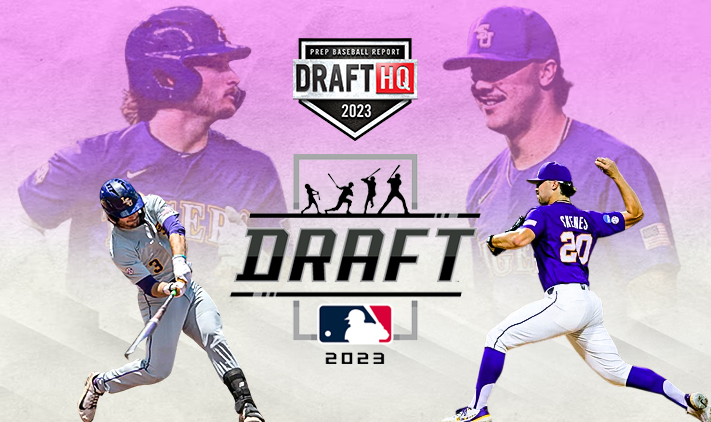What to do at 1.1: College Hitter vs. College Pitcher
June 25, 2023
Tale of the Tape: Who’s No. 1?
Since publishing our final Draft Board update recently, there's one change you'll notice right away: Paul Skenes switched spots with his teammate Dylan Crews at No. 1 overall.
Crews is a five-tool stud and a likely MLB superstar – but how can you ignore Skenes’ historical season, as well as his performance during the College World Series? In his first start against Tennessee, his fastball touched 102 mph, and he pumped 100 or higher on 46 of his 123 total pitches. His fastball averaged a velocity of 99.7 mph. Even with that heat and elite-level movement, he has walked only 19 batters against 200 strikeouts in 114.2 innings this season. And on top of that, he has a plus slider and plus changeup that complete this one-of-a-kind arsenal. He could be an instant big leaguer as soon as he's signed on the dotted line.
Let’s go to the tape...
SCOUT TOOLS (20-80 scale)
After a little digging into the metrics above, we dig deeper with an evaluation of college pitchers vs. college hitters who have been selected with the first overall pick over the past 20 years.
Four-year college pitchers who were selected at No. 1 overall:
- 2018: Casey Mize, RHP, Auburn; top college position player selected: (No. 2) Joey Bart, C, Georgia Tech.
- 2013: Mark Appel, RHP, Stanford; top college position player selected: (No. 2) Kris Bryant, SS, San Diego.
- 2011: Gerrit Cole, RHP, UCLA; top college position player selected: (No. 6) Anthony Rendon, 3B, Rice.
- 2009: Stephen Strasburg, RHP, San Diego State; top college position player selected: (No. 2) Dustin Ackley, OF, North Carolina.
- 2007: David Price, LHP, Vanderbilt; top college position player selected: (No. 5) Matt Wieters, C, Georgia Tech.
Four-year college position players who were selected at No. 1 overall over that span:
- 2021: Henry Davis, C, Louisville; top college pitcher selected: (No. 2) Jack Leiter, RHP, Vanderbilt.
- 2020: Spencer Torkelson, 1B, Arizona State; top college pitcher selected: (No. 3) Max Meyer, RHP, Minnesota.
- 2019: Adley Rutschman, C, Oregon State; top college pitcher selected: (No. 9) Nick Lodolo, LHP, TCU.
- 2015: Dansby Swanson, SS, Vanderbilt; top college pitcher selected: (No. 4) Dillon Tate, RHP, UC Santa Barbara.
No. 1 ANALYSIS
The most Wins Above Replacement generated by a No. 1 overall pick in the past 20 years is a title that belongs to Bryce Harper, who is something of an exception, as an early high school graduate who played in junior college during the spring of what would have been his senior year of high school. As it stands today, Harper's career WAR accumulated is 43.2, per Baseball Reference. Rounding out the top six career WAR totals of the past 20 years from 1.1 picks are; David Price (40.3), Carlos Correa (40.2), Gerrit Cole (37.1), and Stephen Strasburg and Justin Upton are tied for fifth (32.3). Both Correa and Upton were prep picks, while the others were selected out of their respective colleges.
Those six players are split evenly, three college pitchers and three prep hitters. Twenty years is a smaller sample size, but that data alone suggests there is a greater chance for impact as a college pitcher than college hitter. Yes, Adley Rutschman and Henry Davis could change that – and Dansby Swanson has enjoyed a solid career, with a career WAR of 17.7 to date. Conversely, so far, Spencer Torkelson has not lived up to the expectations that come with being a first overall pick.
Speaking of falling short, one could point to 2013 with RHP Mark Appel as a failed No. 1 overall pick, and that would be accurate. But let’s be honest, it was just a poor comprehensive evaluation by the Astros. Another right-hander, Jon Gray selected No. 3 overall that year, was also under consideration for 1.1 and he has accumulated 13.3 WAR over his career. And much has already been written about what could have been had the ‘Stros selected Kris Bryant that year instead.
And even though RHP Casey Mize (2.8) has not achieved what the industry expected since the spring of 2018, he was the consensus top talent in that year’s draft. Brady Singer, Matthew Liberatore, Jonathan India, and Nick Madrigal rounded out the top-five in our Draft Board. Interestingly, Shane McClanahan who was chosen at No. 31 leads all 2018 draftees, to date, with 9.0 WAR in his young career. Singer (5.0), India (5.2) and Madrigal (2.8) each land in the top seven of those who were selected in the first round (Nos. 1-43).
It could also be argued that hitters may have more of an impact during the regular season and pitchers become more valuable during the postseason. Granted, you have to win in the regular season to qualify for the postseason, but that has become easier to do with the continued expansion of the playoffs. For me, impact in the playoffs is just another reason to choose Skenes over any college hitter in this year’s draft class.
The 2023 MLB Draft is one of the rarer in history where a good decision could be made by selecting the best college hitter or the best college pitcher at 1.1. Both Skenes and Crews exhibit nearly equal star-studded upside, albeit on opposite sides of the ball. Only time will tell, and given just how impactful these players might be to an organization, it almost leaves the Nationals in a more enviable position than the Pirates in the sense that a decision will have already been made for them by the time they are on the clock.
Regardless, while my bias skews towards the generational pitching talent, history should take no fault on either decision that the Pirates ultimately make, though if it were me, I’d stick with Skenes.
RELATED CONTENT

